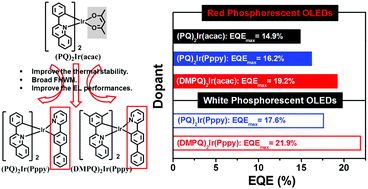Improved luminance and external quantum efficiency of red and white organic light-emitting diodes with iridium(iii) complexes with phenyl-substituted 2-phenylpyridine as a second cyclometalated ligand†
Abstract
Two novel red Ir(III) complexes, (PQ)2Ir(Pppy) and (DMPQ)2Ir(Pppy), based on 2-phenylquinoline (PQ) and 2-(3,5-dimethylphenyl)quinoline (DMPQ) as cyclometalating ligands and 2-[4-(phenyl)phenyl]pyridine (Pppy) as a second cyclometalated ligand were synthesized for use in phosphorescent organic light-emitting diodes (OLEDs). The photoluminescence (PL) of (PQ)2Ir(Pppy) and (DMPQ)2Ir(Pppy) produces red emissions with maximum emission peaks at 602 and 615 nm, respectively. The highest occupied molecular orbital and lowest unoccupied molecular orbital energy levels of (PQ)2Ir(Pppy) and (DMPQ)2Ir(Pppy) were −5.15/−2.97 and −5.13/−2.96 eV, respectively. Red phosphorescent organic light-emitting devices were fabricated based on (PQ)2Ir(Pppy) or (DMPQ)2Ir(Pppy) as red dopants: ITO (50 nm)/PEDOT:PSS (40 nm)/NPB (20 nm)/TCTA (10 nm)/TCTA:TPBi:red dopant (25 nm, 10%)/TPBI (35 nm)/LiF (1 nm)/Al (200 nm). (PQ)2Ir(Pppy) and (DMPQ)2Ir(Pppy) exhibited a very broad full width at half maximum (FWHM) at around 100 nm in electroluminescent (EL) devices, which makes it suitable for fabricating white OLEDs with high colour quality. Among the these devices, the device fabricated by (DMPQ)2Ir(Pppy) of higher PL quantum yields (Φpl) than that of (PQ)2Ir(Pppy) showed an EL emission peak at 617 nm and a maximum external quantum efficiency (EQEmax) of 19.2%. Moreover, a white OLED prepared from (DMPQ)2Ir(Pppy) with FIrpic and Ir(ppy)3 gave the best performance, with an EQEmax of 21.9%, maximum power efficiency of 24.8 lm W−1, luminous efficiency of 40.2 cd A−1, and Commission Internationale de L'Eclairage coordinates of (0.39,0.41) at a luminance of 1000 cd m−2.


 Please wait while we load your content...
Please wait while we load your content...